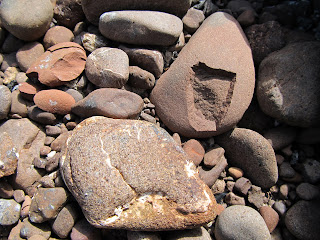 |
| Fresh-baked rock. But would I know that if it weren't so obvious? |
Archaeologists face the challenge of reconstructing the past based on the tiny percentage of it that does not decay, wash away, fall prey to collectors, or otherwise get gone. But before we even get to coaxing tales from stones, we have to find them. In that search, human habits are both boon and bane.
Much as we want to think we are different, that we have higher intelligence, we are animals, mammals with habitat needs, habits hard wired. Until recent generations when urban living and industrial farming has been drained the countrysides and made possible lifeways disconnected from subsistence and survival activities that were typical since we spun off from the ape clan, we have not escaped the biological imperatives. Omnivorous us can adapt to all sorts of environments, but we need to be near fresh water, and we'd prefer some flat ground with a field of vision not entirely obscured by vegetation.
Oh, and we burn things. Lots of people now live in bad habitat rendered acceptable by architecture and infrastructure, but even city dwellers like to have a campfire now and then, and when we head out to do this, often as not we end right back in what our brains' ape lobes recognize as good habitat. Places people camp now often end up having been discovered thousands of years ago. For that matter, a lot of cities are built where towns replaced villages replaced camps replaced the spot where the first human to lope through decided to stop and rest. Habitat preference narrows the archaeological search, because we tend to return to the same old places time and again.
But it also complicates the archaeological record, the stuff left behind by waves of ancient passers-by and rooted residents. For one thing, more recent inhabitants and visitors tend to remove the most obvious and interesting artifacts. Sometimes, people recognize a place as being rich in arrowheads or some other cool thing, and make a concerted effort to take them. Occasionally, the people doing this are careful about it, and make voluminous notes not just about the cool stuff, but broken and dull things as well as the dirt around it all; then it's called archaeology instead of looting. Methods and motivations don't affect the end result much at all, though, the archaeological record is non-renewable, and once disturbed cannot be studied again.
Even if they are not taking things, people make archaeology more difficult. They dig holes for trash or poop, make ruts and spin wheels, and do all sorts of things that churn up the layered sediments archaeologists rely on to tell time. Some of this can be sorted out.
But primitive imperatives also cause us to do things that distort archaeology not by removing or moving artifacts, but by adding imposters. Unless campers are kind enough to toss in some artifacts, a modern campfire can look just like an ancient one. Rock reddened and cracked by the fire, ash and charcoal settling in. All it takes is a few years of leaf fall or a river overflowing its banks and depositing silt to sink the modern campfire and make it harder to determine if it is ancient. Yeah, the technology exists to get a radiocarbon date from the charcoal or piece of deer bone, but the money is not often there. In my job, it's never there.
There was a place I worked at on Moloka'i where we found a bunch of C-shape shelters, a small stone wall (Shaped like which letter? Yes, a C. Very good.) that forms a little windbreak. Hawaiians made them all the time when they were not at their regular house, and when you find a large number, it can mean that the area was heavily used, or was used for a long time. The place I'm thinking of had some sweet potato fields and reefs with fish, so it made sense to find them here. But then I talked with a guy from the island who had joined the marines, and remembered being sent back to his home island for training. Thrilled that maneuvers had brought him to familiar turf (habitat whose subtleties he had previously mastered), he set about teaching the haoles in his unit how to make C-shapes and gather shellfish. The result was new "sites" that looked just like the old ones. Some probably made use of old ones, even. I'd noticed a few shell casings around, but on an island where lots of people hunt and military surplus rifles are common, had just assumed it was re-use of ancient features.
Some tricks of the trade help archaeologists sort our the modern from the ancient, and on balance its better to be studying animals with definite habitat preferences than randomly peripatetic creatures, but human habits can mix things up. I hope we're getting past the 20th Century tendency to dump heaps of glass and metal and plastic everywhere we go, even if it did help sort out ancient from modern activity. The contemporary, environmentally sensitive camper or hunter who leaves behind nothing more than some organic material to decay, maybe some fire cracked rock and charcoal, may make my job more complicated, but I am glad that humans are still humans. It's comforting to look into the fire, chew on some local bounty, and see the past.





No comments:
Post a Comment